The Chinchilla rabbit is known for its supremely soft coat in crisp cool shades of gray. Their flecked coats give them a cute mottled appearance. The Chinchilla bunny started out as a single mixed-purpose meat and pelt breed, and ended up as three distinct breeds which are equally loved as pets. They include the standard, giant and American chinchilla rabbits. Today we’ll help you pick which is the right pet for you, and share tips for raising them and keeping them happy and healthy.
- Where does the Chinchilla rabbit come from?
- The 3 types of Chinchilla rabbit
- Chinchilla rabbits’ appearance
- Chinchilla rabbit temperament
- Health and life expectancy
- Caring for a Chinchilla bunny
- Finding Chinchilla breeders
- Is a Chinchilla rabbit right for me?
In this video, an experienced breeder of show winning Chinchilla rabbits introduces some of the highlights of the breed. Let’s find out more about them!
Where does the Chinchilla rabbit come from?
The Chinchilla rabbit breed started out in France in the early 1900s, as a line of luxuriously soft compact rabbits. They were ideal for providing meat to a small family, and also sported an attractive new type of coat which could be sold to the fur industry. Rabbits matching that original template are still around today, and they are known as Standard Chinchillas. Furthermore, in the last 100 years Standard Chinchillas have been further developed into the American and Giant Chinchilla breeds as well. Let’s look closer at the distinctions between the three types.
Types of Chinchilla rabbit
Today, the three types of Chinchilla rabbit each have their own Standard of Perfection, and they’re all recognized in their own right by the American Rabbit Breeders’ Association. They are:
1. Standard Chinchilla rabbit
Standard Chinchillas were developed in France at the turn of the 20th century, by a gentleman named M. Dybowski. They were the first and original Chinchilla bunny breed, and they are the smallest of the three types.
2. American Chinchilla rabbit
Standard Chinchillas were introduced to America at the New York State Fair in 1919. All the Chinchilla rabbits displayed at the fair were sold to gentlemen named Edward Stahl and James Harris. They selectively bred the largest individuals to create a bigger breed for the American market. The new buns were known as Heavyweight Chinchillas at first, and later they were renamed as American Chinchillas. Of the three Chinchilla rabbit types, Americans are now the least common.
3. Giant Chinchilla rabbit
In 1921 Edward Stahl also launched a line of Giant Chinchilla rabbits, which he created by crossing American Chinchillas with Flemish Giants. American and Giant Chinchillas are both regarded as heritage breeds, deserving of priority conservation.
Chinchilla rabbit sizes
The main distinction between the three types of Chinchilla rabbit is size:
- Standard Chinchillas does (females) weigh 6 to7 pounds, and bucks (males) weigh 5½ to 6½ pounds.
- American Chinchilla does weigh 10 to 12 pounds, and bucks weigh 9 to 11 pounds.
- Giant Chinchilla does weigh 14 to 15 pounds, and bucks 13 to 14 pounds.
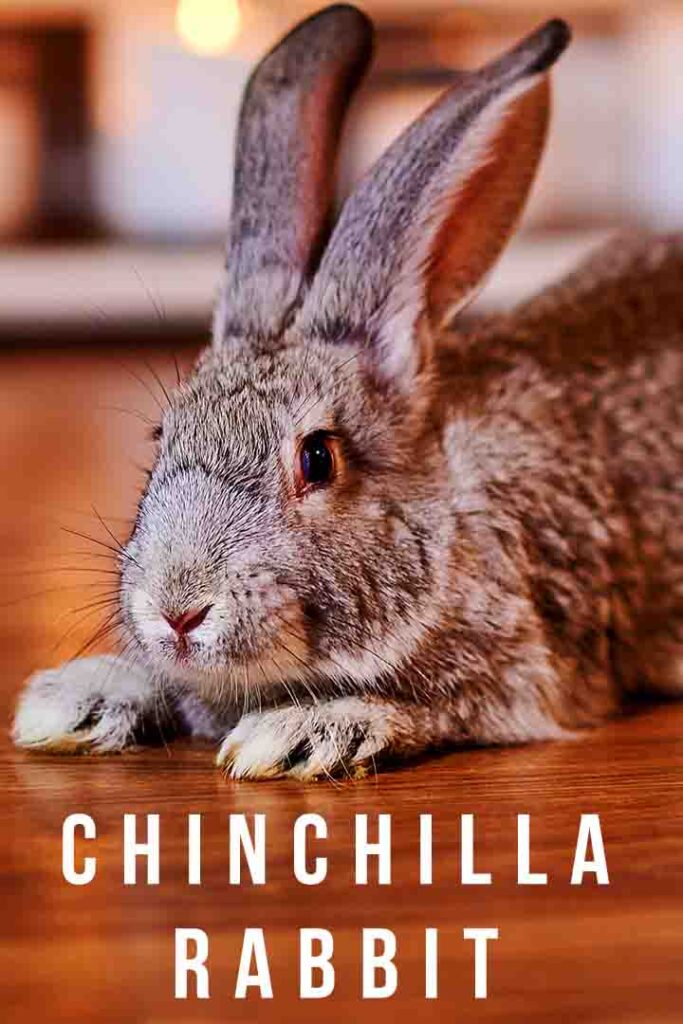
What are the Chinchilla rabbit colors?
What all sizes have in common is their remarkable coat. Not only is it dense and soft, but each guard hair has multiple bands of light and dark black pigment. Working from root to tip, the bands are:
- Undercolor (dark)
- Intermediate color (light)
- Terminal black line (dark)
- First part of the ticked region (white)
- Second part of the ticked region (black tip)
Importantly, the hairs are only tinted with black pigment. So the bands of color are crisp pale gray, cool slate gray, and rich black. Unlike any other breed of rabbit before them, their coat never includes yellow pigment. Other physical features of Chinchillas rabbits are upright ears, fine bones and a full body. Giant Chinchillas and large American Chinchillas might also have a prominent dewlap.
Chinchilla rabbit facts
- The inheritance of a new genetic mutation responsible for the Chinchilla rabbit’s unique coat was first described in an international science journal (aptly named Science) in 1921.
- The Livestock Conservancy believes Chinchilla rabbits have contributed to more modern breeds than any other breed, for example Silver Martens and American Sables.
- Following the development of the American and Giant Chinchilla breeds, Edward Stahl went on to become the first rabbit-made millionaire.
Chinchilla rabbit temperament
Despite starting out as a commercial rabbit for meat and fur, Chinchilllas of all sizes have a reputation for being docile and easy to handle. Which means they’ve steadily gained popularity as pets too. Like all rabbits, they are accustomed to living in a social group. This means that they are calmer, less stressed, more confident and happier when housed with other rabbits. If you raise one from a kitten, they’re likely to be highly sociable and interactive with you, too. Their soft coat is known as a ‘roll back coat’, which means it doesn’t lie stiffly in one direction. In other words, it parts easily when you stroke it or blow on it. So this bunny loves to be petted, and is irresistible to pet!
How easy it is to tame a Chinchilla bunny depends upon things like:
- whether they were well they were socialized to handling by their breeder
- how much patient effort you put into it at home
- and how many generations of pet ancestors they have
Breeders who produced litters of Chinchilla bunnies as pets are more likely to focus on choosing parents with excellent pet temperaments. Over multiple generations, this usually results in kittens which are increasingly tame, docile, and people-oriented. In contrast, commercial breeders prioritize coat quality or meat-to-bone ratio more highly than temperament. All types of Chinchilla rabbits are capable of biting, regardless of their ancestry. But Chinchillas are usually regarded as among the least likely types of bunny to bite. Patient and gentle handling when you bring them home also minimizes the risk of getting off on the wrong foot.
Chinchilla rabbit health
Chinchillas aren’t noted for any significant breed-specific health problems. As a rule, commercial rabbit breeds tend to be quite hardy, since sickly rabbits are not profitable. However, Chinchillas are at risk of all the usual acquired health problems affecting rabbits, including:
- Overgrown teeth
- Obesity
- Parasites
- Viral and bacterial infections
- Flystrike
Chinchilla rabbits typically live for between 6 and 10 years. Standard Chinchillas are more likely to reach the top of this range, whilst giant Chinchillas are the least likely.
Chinchilla rabbit care
If you’re considering bring a Chinchilla rabbit home, you’ll need to provide them with all of the following:
A clean, safe space to live in and exercise.
If it’s indoors it needs to be free from:
- free from electrical cables
- poisonous plants
- heavy items which could fall on them
- anything you’re not happy to be chewed.
If it’s outdoors it needs to:
- have enough space to exercise in
- be secure against predators
- offer protection against hot, cold, and wet weather.
Indoors and out, bunnies like having access to multiple dens for hiding and sleeping in.
What do Chinchilla rabbits need?
A suitable diet.
Rabbits eat mostly hay and grass, supplemented by small quantities of rabbit pellets and fresh vegetables. Fresh water should also be provided in a sipper bottle or bowl. If you use a bowl for a Giant Chinchilla rabbit, check their dewlap every day to make sure it’s not getting, and staying, wet).
A friend.
Rabbits are best kept in all-female groups. You can include a buck, if he’s neutered. If you’re planning to introduce a new Chinchilla rabbit to an established rabbit family at home, introduce them gradually using a pen with a divider in the center of it.
Mental stimulation.
This includes spaces to jump about, opportunities to forage for food from hanging hay balls or inside paper bags, things to gnaw on, and even balls to play with.
Daily attention.
Chinchilla rabbits have low grooming needs, but daily attention is the best way to spot problems like overgrown teeth, diarrhea or flystrike quickly. Rabbits instinctively conceal when they are in pain, so waiting until a problem becomes obvious often means it’s too late to treat it. Interacting with them every day, by teaching them simple commands, hand feeding them treats, or petting them on your lap is good for their emotional and physical wellbeing.
Finding Chinchilla breeders
All three Chinchilla rabbit types have their own national breed club, which are good starting places to look for baby Chinchilla bunnies. You can also search for them online or via word of mouth. Remember that bunnies from pet breeders are more likely to have good pet temperaments than commercial breeders for the fur industry, meat industry, or even the pet store trade. Ask breeders how they socialize kittens used to handling before they leave home.
Occasionally with popular meat and fur breeds, you might also find older bunnies being offered for adoption from commercial settings. Bear in mind that older rabbits that have never been routinely petted are extremely difficult to tame.
Similar Breeds
What if you can’t find a suitable pet Chinchilla rabbit near you? These rabbit breeds are also known for their soft coats and docile personalities:
- Lionhead Rabbit Breed Information Center: Discover The Lionhead Bunny
- Jersey Wooly Rabbit
- Flemish Giant Rabbits
- Mini Lop
Is a Chinchilla rabbit right for me?
In conclusion, Chinchilla rabbits took the meat and fur trade by storm 100 years ago, and some breeding lines went on to become successful pets too. They have sweet, gentle personalities which make them easy to tame and a pleasure to pet. They are generally healthy, and free from hereditary health problems. The main drawback of the Chinchilla breeds is finding one bred from pet parents.
Do you have a Chinchilla rabbit
Do you have a Chinchilla rabbit living at home with you? We’d love to hear all about them in the comments below.
References
- Bourne. Physical and psychological needs of rabbits. The Veterinary Nurse. 2013.
- Bourne. Hay for a healthy rabbit: the importance of appropriate feed. The Veterinary Nurse. 2013.
- Castle. Genetics of the “Chinchilla” Rabbit. Science. 1921.
- Down & Moyes. Helping your clients understand optimal rabbit care. The Veterinary Nurse. 2016.
- Neirurerova et al. Analysis of coat quality of Chinchilla rabbit breed. Scientific Journal for Phytotechnics and Zootechnics. 2019.
- The Livestock Conservancy.

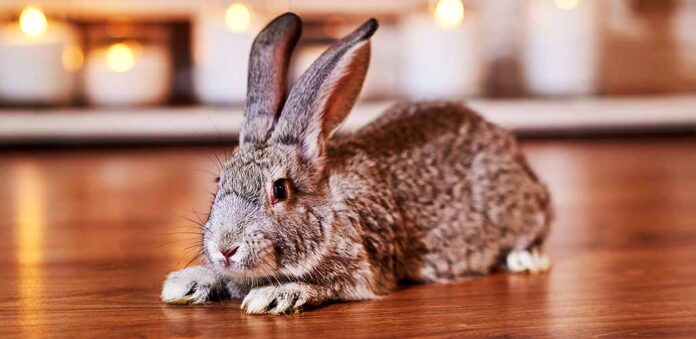
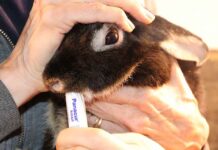
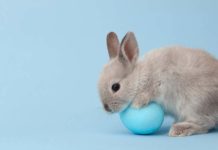
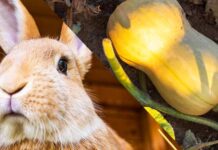










I got my American Chinchilla Rabbit, Ziggy, when he was 8 weeks old. He is the friendliest, most easy-going rabbit I have ever known. It amazes me how he has practically no prey animal instincts. He is not afraid of anything, including my tuxedo cat, with whom he has become the best of friends.
He free roams, uses a litter box perfectly, jumps on and off my bed (loves to sleep with me), and loves music. He also never chews on anything he is not supposed to. Once, when I first got him, he went to chew my iphone cable. I gently told him, “no,” and gave him a piece of hay. That was all it took.
He never ceases to amaze me with how intelligent he is. Now 18 months old, he still learns something new nearly every day. I am going to start walking him with a harness and leash soon.
Our seven year old chinchilla/mini lop is a perfect gentleman. We got him at 10 weeks old. He walks on a leash which he took to almost right away after we got him. We are often requested to bring him to many places. He has been a frequent visitor at our towns nursing home. He accepts the attention the residents want to give him and is always gentle and well mannered with everyone. He and his littermates were going to be released to the wild . Fortunately homes were found for them. I have had no regrets rescuing our sweet boy and could not imagine life without him. I hope he will be around many more years. A bunnies love is like no other.